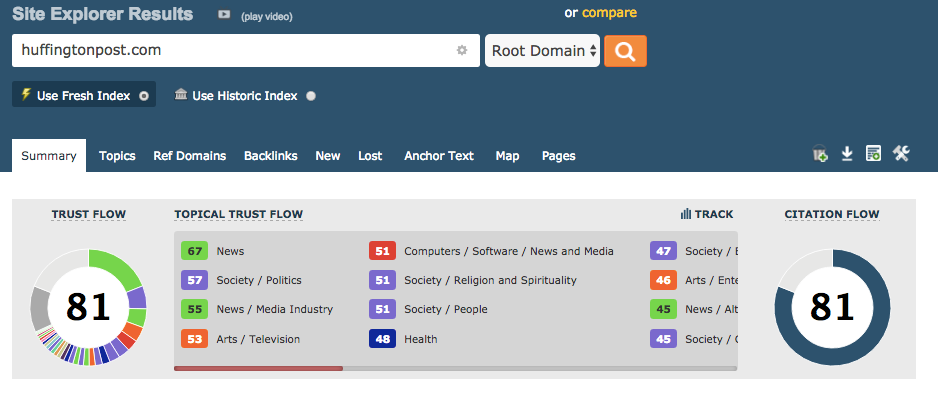At Authority Builders we take the quality of the sites we work with very seriously.
We have a strict verification process.
In fact, less than 13% of the sites that are interested in being promoted via the Authority Builders platform are accepted.
But this isn’t about us; it’s about you.
There are a number of different views on what makes a good quality site for a link.
Introducing the 9 steps
Try it for yourself. In this article, we are going to share with you 9 steps to audit blog post placements that leave you with sites that deliver value. It’s part of what we do at Authority Builders.
Before we talk you through the 9 steps, one important concept that some SEOs need to grasp is metrics (and not to rely on them).
A potential guest post placement is less about metrics and more about traffic, the history of the site, and signals that show the value of the site (or not). Metrics play a part, but only as a tool to paint a picture of the site’s health in general.
With no further adieu, here are the steps. If you have any questions, feel free to ask them in the comments below.
#1 – It starts with traffic
It’s our philosophy that organic traffic is a clear signal that Google trusts the site enough to rank it for keywords. We collect the data using Ahrefs.
Note: We find that traffic isn’t a “must-have”, it’s more of a “nice-to-have”. However, it’s really about trust and future proofing yourself.
If a site has traffic, then it ranks, which means Google likes it.
We use a minimum of 1000 visitors per month as our sign-off criteria.
#2 – Traffic location matters
It’s not just any traffic that is a trust signal; you want traffic that geographically makes sense. The majority of the traffic should come from the country that your website is targetting, unless there’s a logical reason why a site that ranks in Germany would be linked to your site.

#3 – Post labelling
Recent data related to trends strongly suggest that you should avoid any signal your post is a guest post. It should appear to be a standard post. Check the editorial info, no “sponsored by”, no “this post comes from…”, nor author boxes. We avoid these at all cost.
#4 – Visual check – aesthetics
Again, it’s a judgment call rather than a hard and fast yes or no. There are some really ugly-looking sites that have been getting a load of organic traffic for years. But if it isn’t a particularly up-to-date or attractive site, it should make you look more closely at other metrics to ensure you are not placing on PBNs.
We spend a lot of time checking which words they rank for, where their traffic comes from and how active they are on social platforms, to counter site appearance.
#5 – Anchor text
Using SEMRush’s word cloud, we look at the anchor texts. We look for anything that stands out. We want niche relevant anchor texts, and a warning light would be any porn, viagra or other languages (unless it’s relevant). Viagra or porn would be a definite NO; we’d investigate other languages to see if they fit.
#6 – Referring domains
We make a note of the number of referring domains; we also check the quality of those domains. Don’t forget to check if the links that are do-follow or no-follow links because it will affect how much link-juice gets passed through the link you’re looking to place.
#7 – TF / CF ratio
Trust flow and Citation flow matters to us, but not as stand-alone metrics. You should be interested in the ratio between the two scores. If the CF is comparatively high, be concerned the site has too many low-value backlinks. If the ratio is higher, it should provoke you to do a full check.

So, you’ve checked the anchor text, the TF/CF ratio and done a quick manual check of the backlinks checking for value and niche relevancy. If you’ve got this far, you should be optimistic.
#8 – Social activity
Time to check social activity. It really depends on the data that you have beforehand how thoroughly you check social media activity. We are all aware that not every site owner cares about social media, but we also know that if the site is nothing more than a glorified PBN, there will be signals of that on social media.
Look out for low engagement, little to no posting. A load of likes or followers but no activity or engagement is not a good sign. On their own, they are not deal breakers but if you are concerned the site is legitimate or not it will be a good indicator.
#9 – Time to go way, way back
Wayback Machine is a great tool, and every site should have their history checked before you make a decision. You are looking to check that the site has had a consistent history by looking at different points in the past.

If the site has changed hands and it’s still being used for the same kind of content, we might be happy with that, but if there has been a repurposing of the domain, we’re very skeptical. It’s a potential warning sign that the site is being used either as a PBN or an affiliate site and the like.
The takeaways
We have given you an insight into our own 9 step approval process for a site to make it on our database. And unfortunately, for site owners, we tend to air on the side of caution. As a business, quality control is everything. For example, we review each site twice.
We fully recommend this process for your own site verification. This 9 step process will leave you quality, niche relevant sites that should deliver value.
You should start with organic traffic. If Google trusts a site enough to send it organic traffic, that has to be a good signal. But it’s not any traffic; it has to be location relevant traffic.
You also want to ensure that the site is clean, and always has been clean. You should spend a lot of time checking anchor text profiles and the domain’s history to look for signs that the domain has been repurposed.
Finally, the goal is a site with a clean history, good traffic and niche relevancy, don’t get tied down with metrics unless they are helping you to paint a picture.
